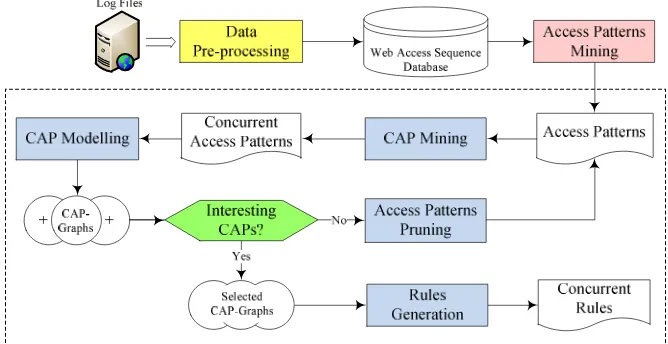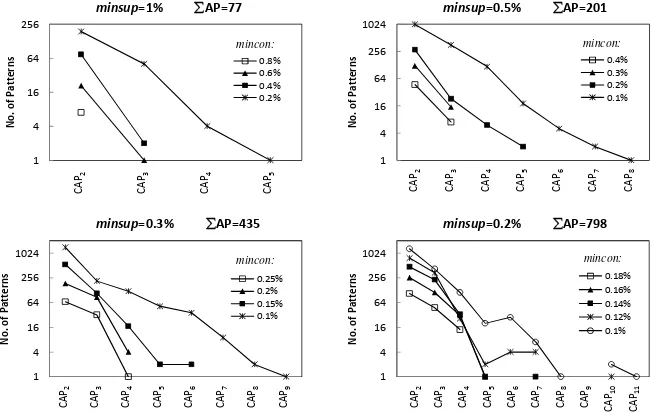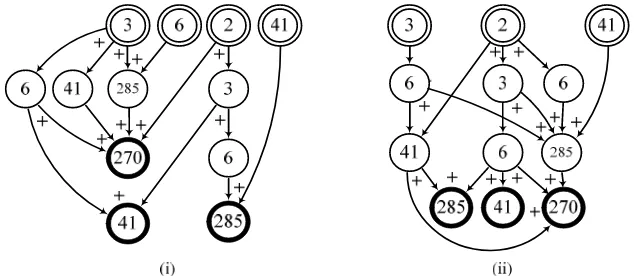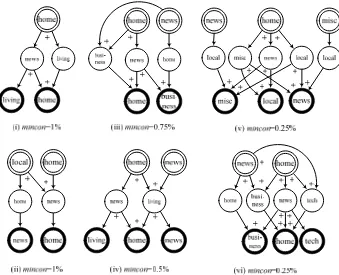L. Bellatreche and M.K. Mohania (Eds.): DaWaK 2013, LNCS 8057, pp. 339–348, 2013. © Springer-Verlag Berlin Heidelberg 2013
Applications of Concurrent Access Patterns in Web
Usage Mining
Jing Lu1, Malcolm Keech2, and Cuiqing Wang3
1
Southampton Solent University, Southampton UK, SO14 0YN 2 University of Bedfordshire, Park Square, Luton UK, LU1 3JU 3
Shenyang University of Chemical Technology, Shenyang China, 110142 Jing.Lu@solent.ac.uk, Malcolm.Keech@beds.ac.uk,
wangcuiqing@126.com
Abstract. This paper builds on the original data mining and modelling research which has proposed the discovery of novel structural relation patterns, applying the approach in web usage mining. The focus of attention here is on concurrent access patterns (CAP), where an overarching framework illuminates the meth-odology for web access patterns post-processing. Data pre-processing, pattern discovery and patterns analysis all proceed in association with access patterns mining, CAP mining and CAP modelling. Pruning and selection of access pat-terns takes place as necessary, allowing further CAP mining and modelling to be pursued in the search for the most interesting concurrent access patterns. It is shown that higher level CAPs can be modelled in a way which brings greater structure to bear on the process of knowledge discovery. Experiments with real-world datasets highlight the applicability of the approach in web navigation.
Keywords: web access patterns (WAP) post-processing, concurrent access pat-terns (CAP), CAP mining and modelling, WAP pruning, knowledge discovery.
1
Introduction
Web usage mining is the process of applying data mining techniques to the discovery of usage patterns from web data to understand and better serve the needs of user navi-gation on the Internet [1]. The method and algorithms for web usage mining are nor-mally divided into three stages: data collection and pre-processing, pattern discovery and patterns analysis. Depending on the ultimate goals and the desired outcomes, there are different types of pattern discovery and analysis techniques such as associa-tion rules generaassocia-tion, sequential patterns mining, cluster analysis and visitor segmen-tation, and classification and prediction based on web/user transactions [2].
Sequential patterns mining attempts to identify frequently observed sequential oc-currence of items across ordered transactions (or sequence databases) over time [3]. This technique has been applied in the web usage context to discover web access patterns (WAP) and to capture frequent navigation paths among user trials. WAP-tree was introduced to facilitate development of algorithms for mining access patterns from pieces of web logs [4]. Analysis of these access patterns allows Internet-based organisations to understand user preferences and predict future visit patterns.
Sometimes the scale and level of detail of access patterns found makes it difficult to identify specific navigation trails in web logs. Structural relation patterns have been introduced to extend the search for more complex patterns hidden behind large se-quences of data [5]. Discovering these patterns is based on post-processing of sequen-tial patterns mining results – those sequensequen-tial patterns supported by the same data sequence have been called concurrent patterns and could be useful for analysing clickstreams. While much of the research in web mining has its focus on efficiency, this paper will pursue concurrent access patterns (CAP) mining and modelling me-thods which both discover and represent new structures not found elsewhere.
Some related work is highlighted in the next section to provide the relevant back-ground on web access patterns mining and structural relations, culminating in the formal definition of concurrent access patterns. Following the novel framework for WAP post-processing in section 3, a CAP mining and graph construction methodology is presented with a worked example to illustrate the approach taken. An experimental evaluation using real datasets is given in section 4 which showcases the effectiveness of CAP mining and modelling at generating new and stimulating results. The paper draws to a close by summarising and making brief conclusions.
2
Related Work
This section will describe two types of related work to provide background and fur-ther motivation – the latter is from the authors’ previous research on sequential pat-terns post-processing.
2.1 Web Access Patterns
Web access patterns have been defined by Pei et al. based on the problem statement of sequential patterns mining [4]. In general, a web log can be regarded as a sequence of user identifier and event pairs. Each piece of web log is a sequence of events from one user or session in chronological order.
Let P = {p1, p2, …, pt} be a set of t items (e.g. web pages). An access sequenceAS
= <as1, as2, …, asm> is an ordered list of itemsets (web pages), where asi∈P, 1≤i≤m.
The number of items in a sequence is known as the length of the access sequence. A sequence AS1 = <X1, X2, …, Xu> is contained in AS2 = <Y1, Y2, …, Yv> if u≤v and
Xi⊆Yj for all i, 1≤i≤u and corresponding j, 1≤j≤v, and it is denoted by AS1∠AS2. A Web Access Sequence Database (WASD) is a set {AS1, AS2, …, ASn}, where each
ASi (1≤i≤n) is an access sequence. The support in WASD of any given AS is defined as
called an Access Pattern in WASD with respect to a minimum support threshold minsup
(0<minsup≤1) if SupWASD(AS)≥minsup. Web access patterns mining thus discovers a set of patterns from a given WASD under a user-specified minsup.
Example 1. Given a small web log that recorded user access to seven web pages
la-belled {a, b, c, d, e, f, g} respectively and let WASD={<abcfge>, <adcbef>, <abfe>, <bfg>}. Table 1 shows the set of all access patterns mined with a minsup of 50% and this will be used as a running worked example throughout the paper.
Table 1. Access patterns from a sample WASD
Sequence Access Patterns Supported by each Sequence (SuppAP), minsup=50%
AS1=abcfge a,b,c,e,f,g,ab,ac,ae,af,be,bf,bg,ce,cf,fe,fg,abe,abf,ace,acf,afe,bfe,bfg,abfe
AS2=adcbef a,b,c,e,f,ab,ac,ae,af,be,bf,ce,cf,abe,abf,ace,acf
AS3=abfe a,b,e,f,ab,ae,af,be,bf,fe,abe,abf,afe,bfe,abfe
AS4=bfg b,f,g,bf,bg,fg,bfg
2.2 Structural Relations and Concurrent Access Patterns
Structural relation patterns have been defined as a general designation of patterns that consists of sequential patterns, concurrent patterns, exclusive patterns, iterative pat-terns and their composition [5]. This sub-section provides the necessary background for concurrent patterns in the web access context.
Following the notation used in the previous sub-section, new ordering relationships based on access patterns can be predicated as follows: given a Web Access Sequence Database WASD = {AS1, AS2, …, ASn}, let α, β be two of the access patterns mined
from WASD with minimum support threshold minsup and assume that α, β are not contained in each other. With regard to a particular sequence AS∈WASD, access patterns α and β have a concurrent relationship if and only if both of them have oc-curred in AS, i.e. (α∠AS)∧(β∠AS) is true. This is represented by [α+β]AS, where the notation ‘+’ represents the concurrent relationship [5].
Definition 1 (Concurrence).The concurrence of access patterns α and β is defined as the fraction of sequences that contains both of the access patterns. This is denoted by concurrence(α,β) = |{ASk:(α∠ASk)∧(β∠ASk)}|/n, where ASk∈WASD, 1≤k≤n and n
is the total number of access sequences.
The user-specified minsup provides the threshold for frequency measurement when mining frequent itemsets, sequential patterns and web access patterns. Another frac-tional value, the minimum concurrence threshold, mincon (0<mincon≤1) is used to check the concurrent relationships of access patterns.
Definition 2 (Concurrent Access Patterns). Let mincon be the user-specified minimum concurrence. The concurrence of access patterns ap1, ap2, …, apr is defined as
concur-rence(ap1, ap2, …, apr) = |{ASk:[ap1+ap2+…+apr]}|/n, where ASk∈WASD and 1≤k≤n. If
concurrence(ap1, ap2, …,apr)≥mincon is satisfied, then ap1, ap2, … and apr are called
concurrent access patterns. This is represented by CAPr = [ap1+ap2+…+apr], where
Example 2. Consider WASD={<abcfge>, <adcbef>, <abfe>, <bfg>} from Example 1 and assume a mincon of 50%. For the access patterns abe, abf, ace and acf shown in bold in Table 1, according to Definition 1, concurrence(abe,abf,ace,acf) = 2/4 = 50%. Therefore, together they constitute the concurrent access pattern given by CAP4 = [abe+abf+ace+acf].
Definition 3 (Maximal CAPs). The concurrent access patterns represented by CAPk
= [a1+a2+…+ak] are contained in CAPk+m = [b1+b2+…+bk+m] if ai∠bj for all i, 1≤i≤k
and corresponding j, 1≤j≤(k+m). This is denoted by CAPk∠CAPk+m. Concurrent
access patterns are called maximal CAPs if they are not contained in any other
con-current patterns.
Note that the CAP4 from Example 2 is also maximal, where this type of pattern represents a navigation trail associated with the most frequently accessed patterns, displaying concurrency beyond the user-specified threshold.
3
Web Access Patterns Post-processing
With the successful implementation of efficient and scalable algorithms for mining web access patterns, it is natural to consider extending the scope of previous study to more structured data mining for enhanced knowledge discovery in web usage.
3.1 Framework
Fig. 1 introduces a novel framework for web access patterns post-processing which can be described through its four rows. First, depending on the nature of the log files, data pre-processing involves different types of tasks such as data fusion and cleaning, user/web page identification and data transformation [2]. The 1st row completes with access patterns mining using traditional sequential patterns mining techniques.
The initial cycle of concurrent pattern discovery proceeds through CAP mining and modelling (2nd row of Fig. 1), which yields CAP-Graphs for analysis (3rd row, see sub-section 3.3). If the CAPs are deemed uninteresting, then access patterns pruning is undertaken before another cycle of pattern discovery is instigated. If at this stage the patterns analysis is successful, through selection of more interesting CAP-Graphs, then concurrent rules can be generated (4th row) and the process completes.
3.2 From WAP to CAP Mining
The method used to mine concurrent access patterns is derived from that for concur-rent sequential patterns [5] and has been highlighted previously in the web mining context [6]. It is illustrated step-by-step below with the running worked example.
Step 1. Calculation of Access Patterns Supported by each Sequence.
Access patterns which are supported by a sequence ASi (i.e. ASi∈WASD, 1≤i≤n)
are computed and denoted by: SuppAP(ASi) = {ap: ap∈AP∧ap∠ASi}.
The results of this for Example 1 are shown in the second column of Table 1.
Step 2. Determination of Concurrent Access Patterns.
Each SuppAP(ASi) can be viewed as a transaction, i.e. the unordered set of access
patterns supported by data sequence ASi. Thus, the problem of finding the concurrent
access patterns which satisfy the specified minimum concurrence (mincon) becomes one of mining frequent itemsets under minsup=mincon.
To calculate CAPs with mincon=50% means finding the groups of access patterns which occur together in at least 50% of the data sequences. In Example 1, both data sequences AS1 and AS2 support the common set of access patterns which constitutes
CAP = [a+b+c+e+f+ab+ac+ae+af+be+bf+ce+cf+abe+abf+ace+acf].
Step 3. Finding Maximal Concurrent Access Patterns.
According to the containing relationship among sequences, the CAPs need to be simplified in order to deduce the maximal concurrent patterns. Using Definition 3, these can be obtained by deleting the concurrent access patterns which are contained by other CAPs, then deleting the access patterns in particular CAPs (in turn) which are contained by other access patterns within the same CAP.
For example, for the CAP from the previous step, the following contained relation-ships exist: a∠af∠acf, b∠ab∠abe, c∠ce∠ace, ... ; therefore this concurrent access pattern can be reduced to the maximal CAP4 = [abe+abf+ace+acf].
3.3 CAP Modelling and Knowledge Representation
The use of graphical models in data mining has motivated the development of a se-quential patterns graph, SPG that explores the inherent relationships among these patterns. The idea was adapted in [7] for modelling concurrent sequential patterns.
Without dwelling on the detail, in this context concurrent access patterns graph (CAP-Graph) is thus a graphical representation of CAPs which maps a function from a set of directed edges to a set of pairs of nodes (see [7]). The definition of CAP-Graph is an extension of that for sequential patterns graph and therefore the method to construct SPG can be adapted for CAP modelling.
For the running worked example, and following initialisation, the intermediate construction and iteration phases proceed as illustrated in Fig. 2. By taking sequential patterns in turn, nodes and directed edges are added step-by-step, culminating in the final CAP-Graph for CAP4=[abe+abf+ace+acf].
Fig. 2. Modelling CAP4=[abe+abf+ace+acf] using adapted SPG method
We conclude WAP post-processing by indicating another way to simulate know-ledge representation here through concurrent rules. For example, the following rules can be generated based on the above CAP-Graph: a[b+c][e+f]. This may be used to predict visit patterns: after accessing page a, visitors are likely to access pages b
and c (in no particular order), followed by further visiting pages e and f.
4
Experiments and Evaluation
The empirical analysis of the proposed CAP mining and modelling methods was per-formed on real-world datasets to test their effectiveness as well as to further illustrate the framework and process for web access patterns post-processing.
4.1 Pre-processing Real Datasets
The initial focus is on pre-processing real datasets available from published sources, namely BMS-WebView-1 and msnbc.com.
BMS-WebView-1 was the first of the three KDD CUP 2000 datasets, which is sometimes called "Gazelle" [8]. This dataset contains clickstream data from a former web retailer, Gazelle.com, and has been used widely to assess the performance of frequent patterns mining. The particular file here contains 59,602 sequences and has been pre-processed already, which is convenient, although the inherent meaning of the 497 items no longer features in the competition web site.
to page views of a user during that 24-hour period and each event (item) in the se-quence corresponds to a user's request for a page.
For web access patterns mining, the original ordering of the pages is important. If a page appears twice in succession in the same sequence, then only the first request will remain following pre-processing. There are many such sequences for the msnbc dataset which contain repetitive/adjacent items or single items only. Therefore, pre-processing has been extended for the experiments which reduces data sequences by 60%. The final file has been divided fairly equally into four datasets called msnbc1.dat to msnbc4.dat, with each processed separately, to make computation more manageable.
4.2 BMS-WebView-1
All experiments have been conducted on a 2.5GHz Intel Core i5 processor with 4GB main memory running Windows 7. Appropriate use has been made of PrefixSpan for access patterns mining, an open-source data mining package available from [10].
1 4 16 64 256 No . o f Pat te rn s
minsup=1% AP=77
0.8% 0.6% 0.4% 0.2% mincon: CAP 2 CAP 3 CAP 4 CAP 5 1 4 16 64 256 1024 No . o f Pat te rn s
minsup=0.5% AP=201
0.4% 0.3% 0.2% 0.1% mincon: CAP 2 CAP 3 CAP 4 CAP 5 CAP 6 CAP 7 CAP 8 1 4 16 64 256 1024 No . o f Pat te rn s
minsup=0.3% AP=435
0.25% 0.2% 0.15% 0.1% mincon: CAP 2 CAP 3 CAP 4 CAP 5 CAP 6 CAP 7 CAP 8 CAP 9 1 4 16 64 256 1024 No . o f Pat te rn s
minsup=0.2% AP=798
0.18% 0.16% 0.14% 0.12% 0.1% mincon: CAP 2 CAP 3 CAP 4 CAP 5 CAP 6 CAP 7 CAP 8 CAP 9 CAP 10 CAP 11
Fig. 3. CAPs mined from BMS-WebView-1 under various minsup and mincon
Several tests have been performed on BMS-WebView-1 across a range of minsup
values – no CAPs were found beyond a 2% threshold. A summary of the nature of these results is shown in Fig. 3 when minsup=1%, 0.5%, 0.3% and 0.2%. It is noted that the number of patterns increases as mincon thresholds decrease within the same
when minsup=0.3%, the number of CAPs exceeds 2,000 once mincon≤0.08, which suggests a natural cut-off point for presentational purposes here.
Two novel and interesting CAP-Graphs are selected from BMS-WebView-1 results and highlighted in Fig. 4, where CAP9 and CAP11 patterns demonstrate that complex structural relations can be discovered and modelled from web usage data.
Fig. 4. Sample (i) CAP9 when minsup=0.3% and (ii) CAP11 when minsup=0.2%; mincon=0.1%
4.3 msnbc.com
The second set of tests was performed on the msnbc dataset, where no CAPs were found for minsup≥7%. Following preliminary access patterns mining with minsup=5%, several CAPs were discovered with repetitive formats and modelling results confirmed these CAPs were not interesting. msnbc is a dense dataset containing only 17 different items and this causes significant repetition in the access patterns. Therefore, to im-prove the mining results, WAPs have been pruned by removing repetitive and adjacent items while deleting single length patterns not useful in the context of concurrency.
CAP mining thus resumes based on the pruned WAPs before CAP modelling once more helps to determine whether there are any interesting patterns. This sub-section presents selected results from the msnbc1 dataset only, although experiments were also performed on msnbc2-4 which were essentially equivalent. Initial tests with minsup=5% show a progression of the highest level patterns from a single CAP2 to a pair of CAP3 to a single CAP4 then a single CAP5 as mincon decreases from 4% to 1%.
Varying the minsup threshold below 5% increases the number of access patterns as well as the potential for CAP discovery. This is best illustrated for minsup=1%, where a representative sample of the highest level CAP-Graphs can be selected, as in Fig. 5.
Fig. 5. Examples of CAP-Graphs for msnbc1.dat when minsup=1% under various mincon
5
Conclusion
The focus of this work has been on the application of original data mining and model-ling research to the web mining context. In particular, concurrent access patterns are defined and explored through an approach to web access patterns post-processing which employs a novel framework for knowledge discovery and analysis in Fig. 1. Constituent data mining and modelling techniques yield concurrent access patterns and graphs allowing the question to be raised: are these CAPs interesting? This calls to some extent for a subjective judgement, but careful inspection of CAP-Graphs provides enough evidence to inform a suitable answer.
The extent to which higher level CAPs can be discovered is first examined for BMS-WebView-1, where results are reported in Fig. 3 for 0.2%≤minsup≤1%. The connectivity and structure of the sample CAP-Graphs shown in Fig. 4 highlights the potential for knowledge representation through concurrent patterns, albeit with no attached meaning here for this web retail dataset. Pre-processing is required for msnbc.com before it is divided into four for individual investigations across 1%≤minsup≤5%. When the lower minsup value is explored in tandem with decreasing
mincon then, following access patterns pruning, the progressive nature of structural relations modelled unfolds in Fig. 5. The higher level CAPs convey the increasingly rich navigation of real pages viewed in this media context.
Future work is being considered in three directions: first, while concurrent rules are suggested in this paper, a specific study of their role and generation would be useful. Second, while CAP modelling presents a stimulating visualisation of mining results, there can be many CAP-Graphs to view for large-scale datasets – a more automated approach to CAP selection would be worthwhile. And finally, while the WAP post-processing framework does not limit the number of iterations in pursuit of the most interesting CAPs, a single additional cycle is illustrated in experiments here. Criteria could be developed for further access patterns pruning informed by other types of constraint relevant to concurrency and applied more widely.
References
1. Srivastava, J., Cooley, R., Deshpande, M., Tan, P.N.: Web Usage Mining: Discovery and Applications of Usage Patterns from Web Data. SIGKDD Explorations 1(2), 12–23 (2000) 2. Liu, B.: Web Data Mining – Exploring Hyperlinks, Contents, and Usage Data. Book
series: Data-Centric Systems and Applications. Springer, Heidelberg (2011)
3. Agrawal, R., Srikant, R.: Mining Sequential Patterns. In: 11th International Conference on Data Engineering, pp. 3–14. IEEE Computer Society Press, Taipei (1995)
4. Pei, J., Han, J., Mortazavi-asl, B., Zhu, H.: Mining Access Patterns Efficiently from Web Logs. In: Terano, T., Liu, H., Chen, A.L.P. (eds.) PAKDD 2000. LNCS, vol. 1805, pp. 396–407. Springer, Heidelberg (2000)
5. Lu, J., Chen, W.R., Adjei, O., Keech, M.: Sequential Patterns Post-Processing for Struc-tural Relation Patterns Mining. International Journal of Data Warehousing and Min-ing 4(3), 71–89 (2008)
6. Lu, J., Keech, M., Chen, W.R.: Concurrency in Web Access Patterns Mining. In: Interna-tional Conference on Data Mining, vol. 58, pp. 600–609. WASET, Venice (2009)
7. Lu, J., Chen, W.R., Keech, M.: Graph-based Modelling of Concurrent Sequential Patterns. International Journal of Data Warehousing and Mining 6(2), 41–58 (2010)
8. Kohavi, R., Brodley, C., Frasca, B., Mason, L., Zheng, Z.: KDD-Cup 2000 Organizers’ Report: Peeling the Onion. SIGKDD Explorations 2(2), 86–98 (2000)
9. UCI KDD Archive,

![Fig. 2. Modelling CAP4=[abe+abf+ace+acf] using adapted SPG method](https://thumb-us.123doks.com/thumbv2/123dok_us/9689190.1951897/6.595.120.474.268.355/fig-modelling-cap-abe-using-adapted-spg-method.webp)


